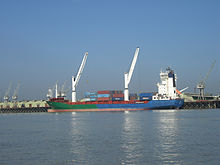Port of Chittagong
| Port of Chittagong | |
|---|---|

Port of Chittagong
|
|
| Location | |
| Country | Bangladesh |
| Location | Chittagong, Chittagong Division |
| Coordinates | 22°18′47″N 91°48′00″E / 22.313°N 91.800°ECoordinates: 22°18′47″N 91°48′00″E / 22.313°N 91.800°E |
| Details | |
| Opened | 1887 |
| Operated by | Chittagong Port Authority |
| Owned by | Government of Bangladesh |
| Statistics | |
| Annual cargo tonnage | 43.37 million (2012–13) |
|
Website cpa |
|
The Port of Chittagong (Bengali: চট্টগ্রাম বন্দর) is the largest seaport in Bangladesh, located by the estuary of the Karnaphuli River in Patenga, near the city of Chittagong. Historically, it is the most important port of Bangladesh and has been playing an essential part in the economic development of the country. It is a deep water seaport dominated by trade in containerised manufactured products (especially garments, jute and jute goods, leather products, fertilizers and seafood), raw materials and to a lesser extent passengers.
Window berthing system was introduced at the seaport on 6 August 2007, enabling the sea port to provide the arrival and departure times of all ships. Two berths at the port terminal are kept in reserve for emergency. In 2011, the port handled 43 million tonnes of cargo and 1.4 million tonnes of containers. The port handled 1.5 million TEUs (twenty equivalent units) containers in 2010–11, up from 1.2 million TEUs in the previous year, according to the CPA Traffic Department. Port of Chittagong is ranked as world's 90th busiest port in the world in 2013.
The history of Chittagong port dates back to the fourth century B.C. Malayan history chronicles the journey of the sailor Buddha Gupta from Chittagong to Malaya in the 4th century B.C. The Periplus of the Erythraean Sea documents the existence of Chittagong port in the ancient times. The Arab traders considered Chittagong to be the delta of the Ganges.
Chittagong port has been mentioned in the works of Ptolemy, Fa-hien, Hieu-en tsng, and Ibn Battuta. This was an important port used by the traders from the Middle East, China, Turkey, Europe to trade with this part of the world.
Arab traders who arrived in the 8th century played a pivotal role in the spread of Islam in Bengal. During the 9th century the activities of the port increased tremendously as the Arab traders started using the port. They used to call the port "Samunda". The port was under their control at the time. In the 15th century the port served as an important place for the re-export of goods produced in China.
The 16th century saw the arrival of the Portuguese. The Arakan Kingdom provided permission to the Portuguese and used them as a buffer against Mughal Empire. The Portuguese engaged in Piracy, Slavery and forced conversion in the region. João da Silveira was the first Portuguese Captain to reach the port. He arrived with his ship Lopo Soana in 1517. The Portuguese named the port "PORTO GRANDE" (a great Port ). The records show that the Porto Grande offered easy access and safe anchorage to ships of 20 feet draught. In 1552 De Barros described Chittagong as the "most famous and wealthy city in Bengal" due to the port of Chittagong which was responsible for all trade in the region. Chittagong port was an vital port to the Arakan Kingdom.The Arakanese lost it to the Mughal empire in 1660s. The loss of the port reduced the fortunes of the Kingdom.
...
Wikipedia
